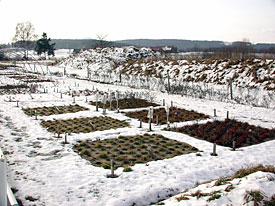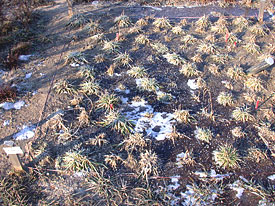Press release from January 26th, 2009
Climate change enhances grassland productivity
More frequent freeze-thaw cycles intensify soil processes
Bayreuth/Leipzig. More frequent freeze-thaw cycles in winter can increase biomass production according to the results of a recent study conducted by the Helmholtz Center for Environmental Research (UFZ), the University of Bayreuth and the Helmholtz Center in Munich. For their experiment at the Ecological-Botanical Garden of the University of Bayreuth the researchers installed underground heating on their plots, thereby enabling five additional thawing periods to take place in the winter of 2005/2006. They found that on the manipulated plots ten percent more biomass grew compared to on the control plots. Such increased plant productivity can be explained by several factors, like for example an increase in nitrogen supply in the spring, according to the researchers account in the scientific journal New Phytologist.

For their experiment at the Ecological-Botanical Garden of the University of Bayreuth
the researchers installed underground heating on their plots, thereby enabling five additional thawing periods to
take place in the winter of 2005/2006.
Photo: Dr. Jürgen Kreyling/University of Bayreuth

Due to global warming and a greater absence of an insulating snow cover, these cyclic processes are likely to increase. In spite of this and apart from a study from the North of Sweden there are hitherto practically no investigations that have conducted research on the significance of these cyclic processes for plants.
Photo: Dr. Jürgen Kreyling/University of Bayreuth
Soils that experience seasonal freeze-thaw cycles currently cover c. 55 million km2. This equates to more than half of the total land area of the northern hemisphere. Forecasts such as the IPCC-Report 2007 anticipate that due to global warming the soil temperature there in the future will fluctuate more frequently around the freezing point. The change between freeze-thaw cycles is considered to be one of the major factors for the release of nitrogen into the soil and consequently for an increase in microbial activity.
Due to global warming and a greater absence of an insulating snow cover, these cyclic processes are likely to increase. In spite of this and apart from a study from the North of Sweden there are hitherto practically no investigations that have conducted research on the significance of these cyclic processes for plants. Scientists working together with Jürgen Kreyling therefore set up an experimental site on the outskirts of Bayreuth to investigate the effects of extreme weather events such as droughts, torrential rain and freeze-thaw processes. The site is located at the transition between oceanic and continental climates, where the average air temperature in January is -1° C. On 30 of the 4m2 plots one hundred common plants (grasses and herbs) were planted. As soon as the temperature had remained continuously below 0° C for 48 hours the soil was heated until the temperature remained above 0° C for 48 hours. In the cold winter of 2005/06, which was 2° C colder than the long-term average, there were a total of 62 days with ground frost. The researchers added 5 artificial freeze-thaw cycles to the three natural ones and compared the results from the different plots.
In the following summer the plants were
harvested twice, dried and then weighed. Here it was found that the manipulated plots produced 10 percent more above-ground
biomass than the control plots on which in the previous winter less freeze-thaw cycles had occurred. In comparison it
was also found that root length up to five centimetres soil depth was reduced.
Tilo Arnhold
Publication
Juergen Kreyling, Carl Beierkuhnlein, Karin Pritsch, Michael Schloter and Anke Jentsch:
Recurrent soil freeze - thaw cycles enhance grassland productivity.
New Phytologist (2008) 177: 938-945.
doi: 10.1111/j.1469-8137.2007.02309.x
www3.interscience.wiley.com/journal/119394679/abstract?CRETRY=1&SRETRY=0
More informationen:
Dr. Jürgen Kreyling
University of Bayreuth/ Helmholtz Centre for Environmental Research (UFZ)
Phone: +49 921-552256
Dr. Jürgen Kreyling (Uni Bayreuth)
Dr. Jürgen Kreyling (UFZ)
Prof. Anke Jentsch
Helmholtz Centre for Environmental Research (UFZ)/ University of Bayreuth
Telefon: +49 341-235- 2100, +49 921-552290
Prof. Anke Jentsch
or
Helmholtz Centre for Environmental Research (UFZ)
Press office
Tilo Arnhold
Phone +49 341 235
presse@ufz.de
Further links:
Research project EVENT:
Website EVENT
At the Helmholtz Centre for Environmental Research (UFZ) scientists research the causes and consequences of far-reaching environmental changes. They study water resources, biological diversity, the consequences of climate change and adaptation possibilities, environmental and biotechnologies, bio energy, the behaviour of chemicals in the environment and their effect on health, as well as modelling and social science issues. Their guiding research principle is supporting the sustainable use of natural resources and helping to secure these basic requirements of life over the long term under the influence of global change. The UFZ employs 900 people at its sites in Leipzig, Halle and Magdeburg. It is funded by the German government and by the states of Saxony and Saxony-Anhalt.
The Helmholtz Association helps solve major, pressing challenges facing society, science and the economy with top scientific achievements in six research areas: Energy, Earth and Environment, Health, Key Technologies, Structure of Matter, Transport and Space. With 25,700 employees in 15 research centres and an annual budget of around EUR 2.3 billion, the Helmholtz Association is Germany’s largest scientific organisation. Its work follows in the tradition of the great natural scientist Hermann von Helmholtz (1821-1894).
